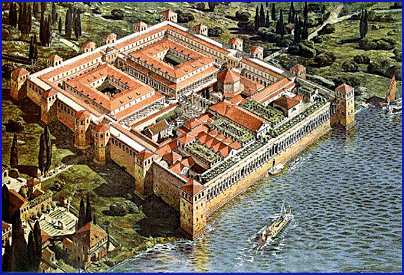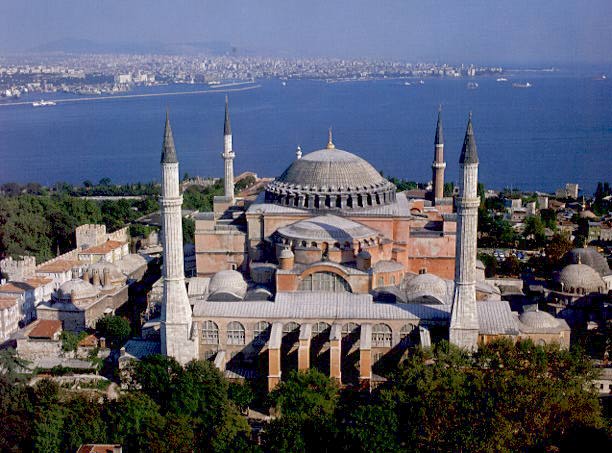The Great Persecution (303–311)
Pressed by his junior emperor  Galerius, the Emperor Diocletian launched the persecution in 303, and then retired two years later to his comfortable palace at Spalatum (Split, in Croatia). The picture here represents what his huge palace looked like: the city centre of modern-day Split actually grew out of the palace. After his retirement, the oversight of the persecution was picked up by others.
Galerius, the Emperor Diocletian launched the persecution in 303, and then retired two years later to his comfortable palace at Spalatum (Split, in Croatia). The picture here represents what his huge palace looked like: the city centre of modern-day Split actually grew out of the palace. After his retirement, the oversight of the persecution was picked up by others.
It's thought that main reasons for the persecution of Christians under Diocletian were to clear the way for a "pagan" revival, which he or his advisers hoped would strengthen the standing of the Emperor (whose office had a religious as well as a political character) and please the pagan intellectual and religious elites.
Diocletian had created a "tetrarchy" with two senior emperors (Augusti), east and west, and two assistant emperors (Caesars), east and west. From time to time, different claimants to the throne led armies against one another. Because of the weaknesses of the tetrarchy and the rivalries and changes in the ranks of leadership, enforcement of the four successive edicts of persecution varied according to time and place. For example, Constantius, the first Caesar appointed by Diocletian (in 293), who was based in Britain with authority over Gaul and Iberia, had no interest in hunting down Christians, though he did order the destruction of churches. Constantius was the father of the future Emperor Constantine.
The Great Persecution continued in force until the Emperor Galerius decreed an edict of toleration in April 311. His motivation in doing so is much discussed. Since Galerius was dying, he may have lost energy for the project, and he may have been struck that persecution was doing considerable damage without attaining its purposes.
Even after the edict of toleration in 311, persecution continued in eastern territories under the usurping Emperor Maximinus II Daia, until a further edict of toleration in 313. And even after that, Emperor Maxentius Daza continued persecutions in his area of authority, and another emperor, Licinus, apparently renewed persecution in his eastern territories in 323. Christians probably didn't feel entirely safe until Constantine secured the sole emperorship in 324.
Constantine
Constantine's accession as Emperor represented a revolution in the fortunes of the Church.
Constantine was acclaimed Augustus in 306 by the military leaders of Britain and Gaul when his father Constantius died in York. The other
Augustus, Galerius, whose court was in Nicomedia of Bithynia, recognized Constantine only as a Caesar. But within a few months Maximian, the retired western Augustus, and his son Maxentius, were claiming the imperial office themselves. The Emperor Galerius tried to neutralize these usurpers, but wasn't fully successful. Civil wars between Maxentius and Constantine followed in 311. The decisive battle took place on October 28, 312, at the Milvian Bridge (pictured here) over the Tiber River near Rome. In the story recounted by the fourth-century bishop Eusebius of Caesarea, Constantine received a vision before the battle: it was the Christian "labarum", a figure featuring the Greek letters chi and rho, the first letters of the Greek word for Christ. Constantine had the sign affixed to the shields of his soldiers, and, against heavy odds, he won the battle the next day, and his foe Maxentius drowned in the river.
Constantine gave particular favour to Christianity after this. He financed church buildings, gave privileges to church officials, and took an interest in theological debates, mainly in order to promote Christian unity, which seemed to him politically advantageous. He was called the "bishop of bishops", though he was not himself baptized until he was on his deathbed.
In February 313 Constantine issued letters to his officials to end all persecution, to release Christians from prison, and to restore the property of Christians that had been seized during the persecution. This action has been called the Edict of Milan. Galerius' edict of 311 hadn't restored Christian property, and it hadn't stopped Maximinus II Daia from his persecutions of Christians in his eastern territories.
Constantinople
Constantine built a new imperial capital at what he modestly called Constantinople (Constantine's city), now Istanbul. The site of Constantinople had previously been called Byzantium. Accordingly, the Roman Empire, during the period when its capital was Constantinople, from 330 to 1453, is often called by historians the Byzantine Empire. (Some historians date the beginning of the Byzantine Empire a bit differently.) The Byzantine Empire came to be largely Christian in religion, largely Greek in culture, and largely Roman in its judicial heritage.
Constantine ordered a cathedral for Constantinople, which is now the most renowned in Eastern Orthodoxy (although it no longer belongs to the Church); it is called Hagia Sophia (pictured here). The cathedral was destroyed twice in the following two centuries, and the present Hagia Sophia was completed under the emperor Justinian in the sixth century.
- (After the conquest of Constantinople by the Muslims in 1453 Hagia Sophia became a mosque. The Republic of Turkey, which was founded in 1923 as the quasi-secular successor state of the Ottoman Empire, made Hagia Sophia a museum in 1934. But in modern Turkey there are constant tensions between Muslims and secularists, and currently the government of President Erdogan has identified with political Islamists. Hagia Sophia became a mosque again in 2020.)
With its capital at Constantinople. the Byzantine Empire acquired a strongly eastern centre of gravity. For a number of reasons, its western territories grew increasingly independent,
in ways that we'll see in the following webpages. Moreover, many of its eastern territories were taken over by the Caliphate in the decades after Muhammad. Over the course of centuries, therefore, the Byzantine Empire shrank in size several times, until finally it was scarcely more than the city of Constantinople itself.
The Monastic Reaction
An imperially favoured and funded religion, as Christianity was becoming, was almost inevitably more worldly than a persecuted religion. The monastic movement was partly a reaction against this worldliness. But it was more than that; a strong ascetic element had existed in Christianity long before Constantine. One of the earliest monastic leaders was St. Anthony "the Great," of Egypt, who died in 356. This monastery, built soon after his death, is supposed to be on the site of his much more humble monastery. It's in mountains near the Red Sea in Egypt, and is still used as a monastery of the Coptic Church. Monasticism in both East and West often became not only spiritual centres but also economic powers and political forces.
Image: the monastery at the site of Antony's hermitage.
